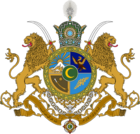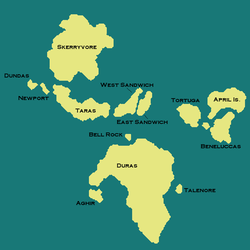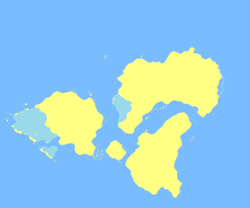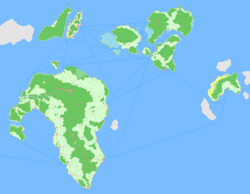Beneluccas
| Benneluccas Benelukken | |||
| Subah of Çakaristan | |||
| |||
| Subdivision | subah | ||
| Capital | Ruhatyn | ||
| Largest cities | |||
| Area | 158,112 km2 | ||
| Population | 959,723 census of 1740 | ||
| Subahdar | |||
| Legislature | |||
| Languages | Batavian | ||
| Time Zone | CMT+5 | ||
| Driving side | right | ||
Beneluccas (Batavian: Benelukken) is a subah (province) within the Çakar Empire. The subah is located between the Captive Sea and the Sea of Storms. It consists of an archipelago of islands that are counted among the Skerry Isles.
The archipelago of the Beneluccas consists of three main islands with a further 182 smaller islands.
Name
The name "Beneluccas" is a contraction of the first two letters of Belgium Netherlands and the addition of a derivative of Jazirat al-Muluk, which means "Island of Kings". The name was created by Erwin V.H.
History
In 1568 Flanders acquired the shared sovereignty over the Beneluccas. The other owner was New Cognito. After a long-drawn conflict over the property rights with the Ashkenatza Republic, Flanders and Ashkenatza closed the Treaty of Ruhatyn in 1592. In this, the management of the part of Ashkenatza was transferred to Flanders. The Flemish part formed the fifth region of Flanders. But Ashkenatza ceased to exist in 1607, as a result of which an uncertain period arose for the archipelago. In 1649, Flanders ceased to exist. A turbulent time of anarchy arose.
In the years 1651 to 1660 the Southern Beneluccas came under the banner of Republic of Gerenia. And in 1663 the northern Beneluccas came under the banner of New Calbion, but that did not last for a Norton year.
Until in 1667 the Congress of the Beneluccas was organized. In order to unify the archipelago and put an end to anarchy, Congress has decided to establish a Kingdom. Because Erwin V.H. is no longer active, Congress has gone looking for another candidate. The choice fell on Margaery des Vinandy.
After the fall of the Franco-Batavian Empire, the Beneluccas faded into The Green. It was only in 1692 AN that Calbion claimed the northern island, after which Batavia claimed the remaining islands. In 1709 AN the islands were united by treaty. In the same year, the islands were handed over to Çakaristan.
During the Sanpo-Çakar War (9.V.1716 AN - 31.XV.1720 AN), the Beneluccas was largely occupied by the Spider Fleet. Between 1720 and 1728 AN, the effects of the Great Skerry-Valencian Drought became evident. The harvest of sugarcane was disappointing. Prices of rum rose immediately. Shortages of water also developed.
Maps
Several maps have been made showing the Benneluccas:
-
Early map of the Skerries Isles
-
First detailed map of the Beneluccas
-
Detailed map of Çakari East Skerries
Economy
Agriculture
During the period when the islands changed flags rapidly, the economy was increasingly dominated by the cultivation of poppies for the narcotics trade. Since the islands came under the Çakar flag, there was an active policy to reduce and even eliminate poppy cultivation altogether. This involved burning down poppy fields and trying to control exports. More other agriculture did appear, such as the cultivation of sugar cane. But after the Great Skerry-Valencian Drought, that rotation proved difficult to sustain. As a result, the government changed its policy and instead of burning down poppy fields, started buying up the crops. A factory, Rho Pharma, was set up to make morphine from the bought-up poppy.
Besides sugar cane and poppy cultivation, products such as coconuts, cotton and cocoa are grown.
Alcohol
Rum and beer brewing have been present in the islands since the early 16th century. Skerry Brand, a West Skerrian brand, is a popular rum on the islands. Between 1696 and 1717, the brand could not be supplied, but despite high prices, there was never a shortage of rum of this brand. A variety of rum brands of their own emerged during that period, some of them then labelled as Skerry Brand. Today, people take pride in their own brews and there is a wide variety of brands.
Petroleum
An oil transfer terminal is located near Schaarlecht. Built in 1668, the terminal acts as intermediate storage for petroleum before it is shipped to a refinery for processing.
Salt mining
The islands have natural salt pans that allowed for large-scale salt extraction. Towards the end of the 17th century, the salt pans ran out and extraction had become uneconomical. A Çakari businessman revived salt production, by constructing artificial salt pans. The Beneluccas Salt Company was established. The Beneluccas are ideally suited to this method of salt extraction, given its location, climate and existing infrastructure.
Tourism
Despite its troubled recent history, the islands are popular with tourists. Mainly because of their excellent diving facilities, magnificent beaches and wonderful nature.
| ||||||||||||||||||||||||||||||||||||||||||||||||||||||||||||||||||





